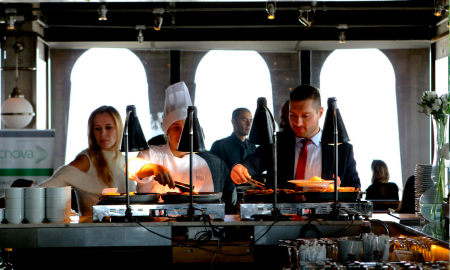How To Make Your Catering Business More Sustainable In 2025

Global warming continues to be one of the biggest issues humanity faces, and everyone has an important part in mitigating the damage.
In the last 10 years, big efforts have been made to reduce the amount of waste businesses produce and to make day-to-day running more energy efficient. The catering industry has been under fire as one of the biggest contributors to climate change outside of factory-based industry, so if you’re in the food and drink business, you’re likely wondering how to do your part.
This article is here to help with that. Here are a few of the most impactful decisions you can make to protect the planet as you continue to grow.
Source Locally Where You Can
While it might not be possible to source all of your ingredients locally, you’ll most certainly be able to do so to some extent. Opting for locally produced products is one of the best things you can do for the environment as a catering business, as this way, the stuff you need on a daily basis doesn’t come with the negatives of having to travel over long distances.
Not only does this drastically cut down your contribution to global vehicle emissions, but customers also favour local produce for its quality and flavour, so it’s really a win-win.
Utilise Sustainable Packaging
When governing organisations talk about the environmental impact of the catering industry, a large part of their focus is on packaging waste.
No matter whether you run a high-end restaurant in a swanky part of town or a popular takeaway in a student area, you’ll produce a lot of rubbish. There’s both the packaging you give customers to consider, as well as the bags and boxes your ingredients come in.
Partnering with an eco-friendly packaging company is a big step forward, as even if your packaging is carelessly discarded, you know it’s biodegradable.
Don’t Forget About Energy Efficiency
Energy efficiency may not be the first thought when it comes to running your catering business, but take a moment to consider your premises.
Say you run a restaurant. There are likely dozens of lights powering the dining area, which includes lamps for individual tables. Then, in the kitchen, you have numerous industrial-grade appliances, and given the fast-paced nature of this line of work, you’re burning through vast quantities of gas and electricity each day.
Making small changes is where it’s at. You could consider switching to LED light bulbs, for example, which have a drastically reduced energy profile compared to traditional incandescent bulbs, and with careful selection of your appliances, you can have a kitchen stocked up with energy-efficient gear that both saves you money and helps the planet.
 Offer Plant-Based Options
Offer Plant-Based Options
Different foods have different environmental footprints associated with their production, so what you put on the menu matters. Meat products traditionally require much more energy to produce, so offering more plant-based options is a sure-fire way to reduce your impact across the board.
Consider making dishes using ingredients such as lentils, beans, and tofu instead. There are also products like mycoprotein, under the brand name Quorn, which has a nutritional profile comparable to meat and comes in many shapes and sizes.
Educate Your Staff
You can’t implement environmentally friendly practices without first running through how they work with your staff. Everyone who works for you will need to be on board with establishing better habits moving forward, so train them on sustainable practices in whatever area of the business they’re involved with.
You should also post laminated signs throughout the kitchen and staff areas as reminders, and it’s a good idea to remind your customers as well. You don’t have to do so in a heavy-handed way – just a polite reminder in the toilets to remember to turn the taps off can go a long way, for example.
Choose Green Cleaning Products
It takes a lot of effort to maintain an eaterie, and as such, there will be plenty of time spent mopping and scrubbing. That means you’ll be going through large quantities of cleaning products, and depending on the brands you choose, these can be very harmful to the environment.
Thankfully, there are now plenty of non-toxic alternatives on the market you can use instead. These are better for the planet and your staff, so you should definitely consider switching.
Wrapping Up
Remember, you don’t have to change everything at once; it’s about making small changes that add up over time. By digging into the points above and making a few tweaks here and there, you can make a big difference. Good luck!
Image sources: Thiago Patrevita and Dennis Ojenomoh via Pexels.






